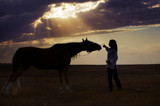Training Your Horse to Deal With Spooky Situations
Known for their hyper vigilance, horses are easy to spook. As prey animals, horses have survived in the wild due to to these ingrained instincts and strong senses.
Whether it is a sudden weather change, a fast running herd on the horizon or fatigue after a long race, many different factors can interfere with the naturally defensive tendencies of your horse. It can be quite difficult to train spooky horses. Yet, it is even more difficult to train soft-natured horses to suitably respond to a spooky situation. Here are some tips you can use to train your horse.
Training for Managing the Good Spooks
Because horses are gifted with a natural flight reaction, seemingly small things such as a crunchy sound in the bushes can cause a horse to take off in an uncontrollable run. With proper training, these things do not have to affect the horse at all. This type of control can be established over time with a variety of techniques. For example, creating crunchy sounds partnered with the right signals for calmness during training is an essential part of teaching your companion how to respond to these situations. Calm B is one of a variety of great calming supplements offered at LVPerformance.com which can be a great addition to your training sessions.
Another response to keep in mind when helping your horse remain in control during a spook is that of leadership. When the horse senses danger that you may be unaware of, it assumes the role of leader and tries to control itself according to the instructions given by the owner. You can help your horse by lowering your head forward or patting its back.
Training for Managing Bad Spooks
Bad spooks are the real dangers which require strict training. The horse may cause serious injury to the rider as well as to itself if this potential situation is not addressed early on. For instance, your horse may feel confused while riding down the mountain. For bad spook management, the following types of trainings are required.
Verbal Training. This includes training your horse to respond to words. Many owners use the words such as ‘Quit’, ‘Stop’ or ‘Pause’ to manage their horse’s behavior. Verbal training also includes controlling the pitch of the voice. For example, ordering in a low voice is used to stop and calm down the animal. Ordering in a high pitched voice is used for keeping the animal calm but moving.
Physical Training. This is used in the situations when you are already riding the horse. It includes stretching or loosening the ropes, holding the head of the horse, hugging its back as a gesture of security, and leaning forward on the horse.
Mistakes to Avoid
- Don’t assume that your horse will not become tensed in a spooky situation. The tension of the horse increases if it feels that the rider is tensed, unsure or anxious. Keep yourself calm and try to breathe deeply in front of the horse. Lower your head as a sign of calmness. Gently pat your horse but try to stay at a little distance to minimize the risk that the animal will hurt you.
- While sitting on the horse, make sure to hold the ropes gently. Many horse owners tighten or loosen up the ropes. The animal may interpret it as either a signal of attack or complete freedom.
- Don’t force your horse to lower its head. Instead, lower your head so that the horse also lowers its head. Make sure to keep your eye on the animal while lowering your head.

